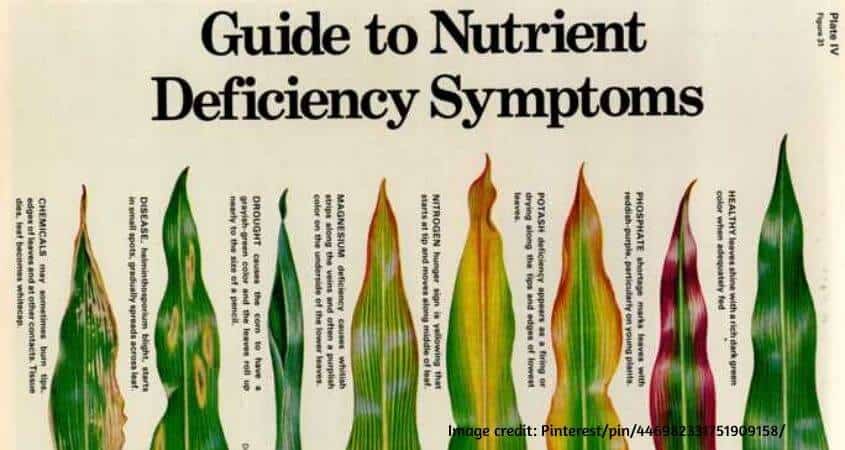
Nutrient deficiency disease symptoms in plants is a common puzzle among crop farmers. In order to determine which nutrients are deficient in your soil and understand your soil better, consider doing a soil analysis for your crops. What follows is a description of visual symptoms of deficiency diseases in plants due to lack of nutrients. While useful as a starting point to diagnosing production problems, keep in mind that multiple nutrition disorders often occur simultaneously.
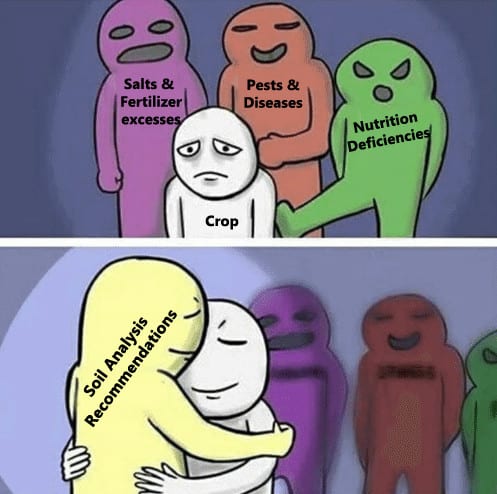
When it comes to Nutrient Deficiency, Protein is essential for all living organisms and is required for growth and development. Nitrogen is one of the main elements in protein, Nitrogen is also a component of nucleic acid, DNA, RNA, genes, chromosomes, enzymes, chlorophyll, secondary metabolites (alkaloids), and amino acids. Nitrogen accounts for about 1 to 6 % of plant dry matter, depending on the species.
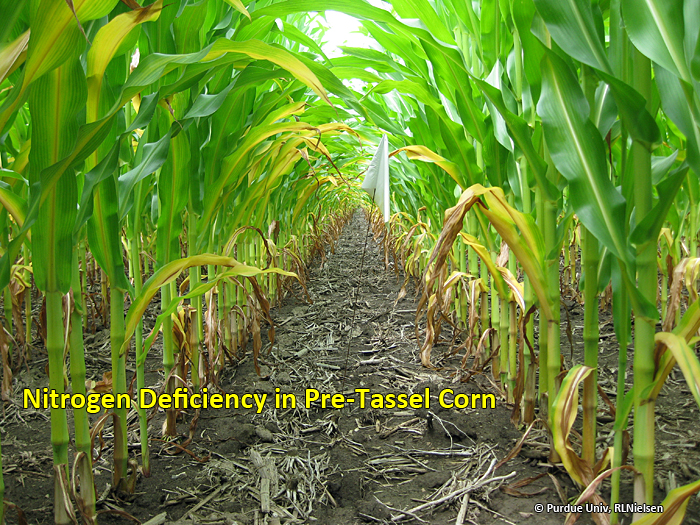
Nitrogen nutrition deficiency slows down the growth and development of plants. Nitrogen deficiency symptoms in plants manifest in a distinct manner. The plants appear stunted with light green lower leaves, while the upper leaves remain green, With prolonged Nitrogen nutrition deficiency, yellowing (chlorosis) of older or lower leaves occurs. This is followed by leaf tip death and leaf margins developing a brown discoloration (necrosis). In some instances, the leaves fall off. The plant sterns become woody.
Phosphorus provides energy in the form of ATP and NADPH for plant metabolism (photosynthesis and respiration). Additionally, it is a component of DNA, RNA, nucleotides, and cell membrane.
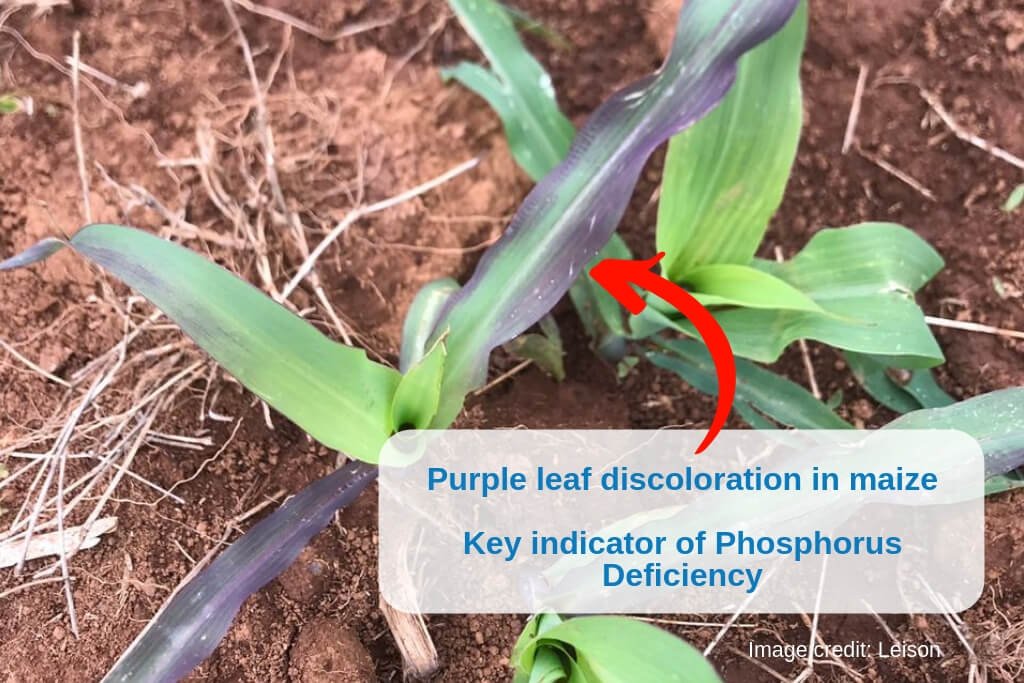
Nutrient Deficiency symptoms of Phosphorus in plants. Initially, plants with P nutrition deficiency appear darker green with reduced growth affecting the leaf size and stem thickness. As Phosphorus nutrition deficiency continues, the older, lower leaves develop irregular spots of brown to dark brown dead tissue. In some plants, reddish to purple pigmentation may appear on the under or upper surface of leaf margins, lower leaves, and stems. Eventually, leaf death of older leaves may occur. In most cases, lack of phosphorus delays flowering in plants.
Unlike nitrogen and phosphorus, potassium is not a component of plant organic matter. Potassium is important for movement of sugars, starch formation, pH stabilization, drought tolerance, cell turgor, enzyme activation, and regulation of stomata opening and closing.
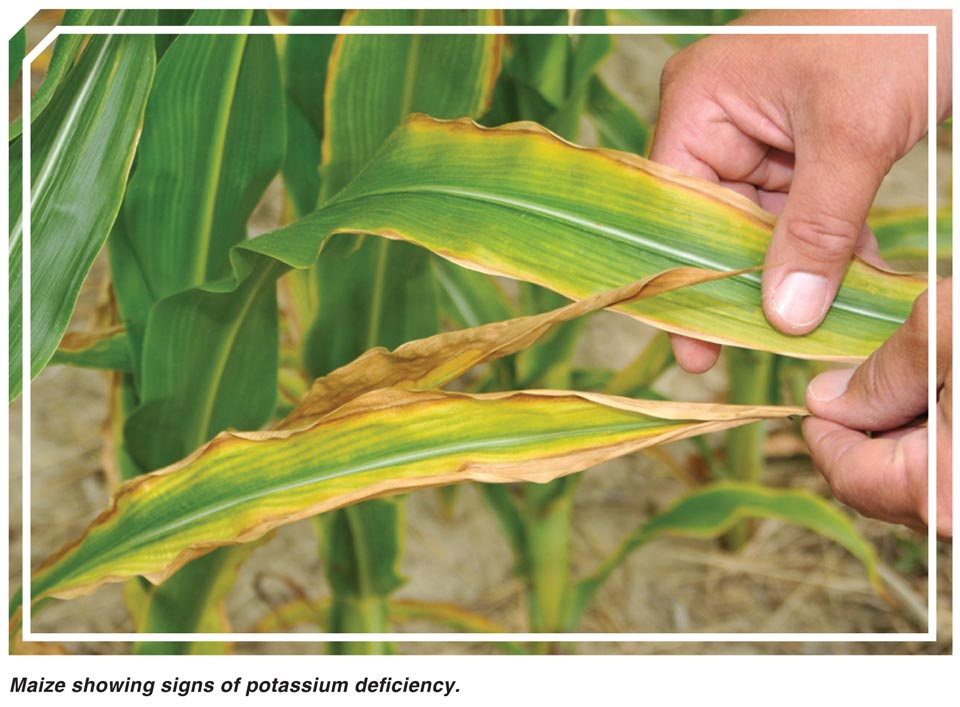
Potassium deficiency in plants manifests in several ways. The leaves of potassium deficient plants are small and dark green. The plants have short internodes resulting in a compact plant appearance. These symptoms are followed by a sudden development of irregular necrotic tissues along the leaf margins and tips of lower, older leaves and eventually covering whole leaves, making the leaves appear scorched. Also, leaves curl downwards.
Calcium is required for cell wall structure and cellular signaling. Calcium is important in cell division, cell expansion, building of cell walls, stomatal regulation, and cold tolerance.

Unlike other nutrients, calcium deficiency generally affects the growing points and young leaves of the plants. The young leaves are often twisted or wrinkled. The growth is reduced with tiny black spots appearing around the mid-leaf area of young leaves and on the tips of very young leaves. In some cases, these black spots appear o the growing points. Abortion of flowers or flower buds is common if calcium is unavailable during flowering. During fruiting lack Calcium nutrition can result in fruit cracking or in water-soaked tissues. Calcium deficiency in tomato plants normally results blossom end rot disease.
Magnesium is a core component of chlorophyll (pigment of photosynthesis). Magnesium is also important in enzyme and co-factor reactions. It is involved in the metabolism and movement of carbohydrates and stabilizing cell membranes.
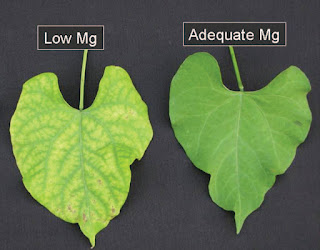
Normally deficiency symptoms of Magnesium in plants appear in lower, older leaves with chlorosis of greenish yellow to yellowish green developing along the leaf margins and tips which progresses inward between the leaf veins. As the Mg nutrition deficiency prolongs, necrosis develops between the veins and the leaf curl downwards, Eventually, leaf and plant death may occur if the magnesium deficiency continues.
Sulfur is essential in protein synthesis as it is a constituent of some essential amino acids such as cystine and methionine. Sulfur is also involved in plant photosynthesis and respiration.
Symptoms of sulfur deficiency in plants: Initially, uniform chlorosis of light greenish-yellow pigmentation develops anywhere between the young and mature leaves, but rarely on lower, older leaves. As the symptoms advance, uniform chlorosis spreads to rest of the leaf area.
Iron is an important component of sulfur proteins. DNA and RNA synthesis is restricted under iron-deficient environments. Iron is also involved in chlorophyll formation. Iron is considered an immobile element in the plant, and as a result, iron nutrition deficiency symptoms in plants develop on young leaves and shoots.
Iron deficiency symptoms in plants symptoms: Generally young leaves develop interveinal chlorosis, from the base, but in some as from the tip. Over time, interveinal chlorosis intensifies and the pattern becomes less interveinal. Even the stems appear chlorotic. At this point, the chlorotic symptoms are irreversible even if correctional measures are taken. Eventually, yellow gives way to white. The bio-availability of Fe is pH dependent; the lower the pH higher the solubility and hence the ability of iron to plants.
Manganese plays a significant role in photosynthesis. The formation of free radicals during water splitting and ultimately the release of oxygen is not possible under Mn-free environments. Mn is the only element that can contribute the necessary electrons for this bio-chemical process.
The young and recently matured leaves develop chlorosis followed by stippling of necrosis on recently matured leaves. Drastic reduction of shoot and root growth is common. Flowering is strongly inhibited. Environmental factors such as sunny summer months, greenhouses built close to traffic areas and ozonated water used in irrigation/fertigation may contribute to
manganese deficiency.
Copper plays an important role in quenching the radicals produced during biochemical processes. It is also a component of proteins and enzymes that are critical in producing ATP the “Biological Currency’. Copper is required for lignification, especially xylem formation, and its mobility is moderate to immobile within the plant.
Initially, the young and maturing leaves appear stunted. In some species a tinge of bluish-green appears, especially over the veins. This is followed by impaired flower development that includes reduced size, premature abscission, or abortion. Sudden death of tissue, with symptoms similar to localized tissue dehydration, develops on recently mature leaves as a result of poor xylem tissue development. Chlorosis is generally not a distinguishing feature.
Substrate with high pH or alkaline water may contribute to Cu nutrition deficiency. Symptoms appear initially at the base of the leaf and spread toward the margins.
Zinc is an integral component of protein; so far, over 80 zinc-containing proteins have been reported. One of them, referred to as “Zinc Fingers’, is actively involved in DNA transcription. This means protein synthesis requires Zinc.
Young and recently matured leaves develop puckering, veinal chlorosis, and necrosis. Some plants develop purple pigmentation. Shoot and root growth is reduced. A high level of P in the substrate induces Zn nutrition deficiency. Zn availability is reduced by high pH and bicarbonates (HCO3-).
Boron is required in plants for cell division, cell wall formation and stabilization, lignification, xylem differentiation, membrane integrity, auxin activity, inhibition of callose formation, nucleic acid metabolism, apical meristem function, pollination and reproduction, and counteracting the toxic effects of Aluminum. The critical B concentration varies among species, and B requirement during the developmental stage is greater than vegetative stage. Almost 90% of plant B is contained in the cell wall.
Like Calcium, Boron disorders develop on the shoot and root meristem, and on young leaves. The symptoms develop on the roots 3 to 4 days earlier than the shoot. Overall, the roots are thick and short while primary roots develop thick swollen root tips with numerous short secondary roots developing close to the tip giving a “witch’s broom” symptom.
Meanwhile, foliage becomes darker and glossy. Young and recently matured leaves become thick, leathery and brittle with severe distortions. Loss of apical dominance is a common symptom in the root and shoots. At this point, it is too late to take any correctional measures.
The requirement of Molybdenum for healthy plants is only 0.1 ppm in the form of Mo(VI) and is available only at high pH (> 6.8). It is involved in the initial step of inorganic nitrate (NO3) assimilation. Therefore, Mo is critical when nitrate is supplied rather than ammoniacal (NH4- N) N. It is important in the biosynthesis of the phyto-hormone abscisic acid, which is required in drought conditions.
Generally, the symptoms appear on the middle and older leaves with interveinal mottling and marginal chlorosis. Eventually, the symptoms progress to upward curling and necrosis of leaf margins. The symptoms are accentuated whenever nitrate-nitrogen (NO3-N) is the sole source of N, and under such conditions, the symptoms of Mo deficiency are similar to N deficiency.
If you’d want more advice on the nutrition level of various elements in your soil or more advice on the symptoms you observe on your crop, kindly contact us on +254 720 639 933 or support@cropnuts.com
Please click on the link to read further on the role of nutrients in on plant disease management.
Adopted from Floriculture Directory 2017 – 2018
Order our services and get to know how to improve your soil for better yeilds.